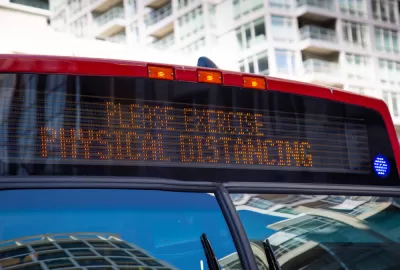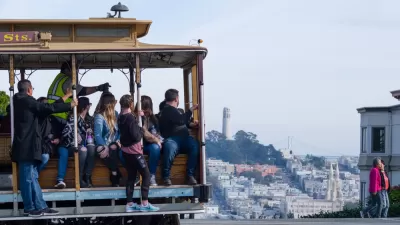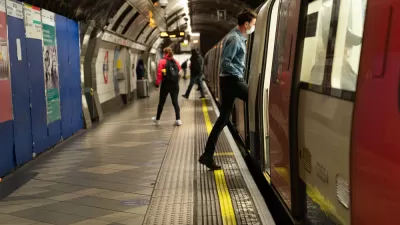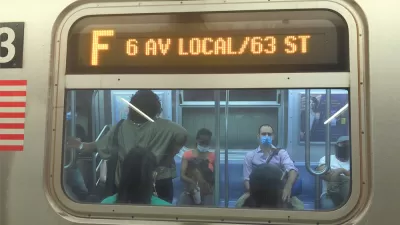U.S. public transit agencies have been reacting to news and developments on the fly, as sudden declines in ridership, loss of revenue, waves of protest, and an uncertain long-term prognosis continues to disrupt day-to-day operations.

Planetizen has been monitoring the rapidly evolving reality of public transit during the pandemic—at the very beginning, the sudden decline in public transit ridership was one of the earliest indications of how quickly the coronavirus would disrupt daily life in the United States, and how those disruptions were likely to have a disproportionate impact on the most vulnerable Americans.
In early June, as budget season approached and New York City and the Northeast emerged from the terrible scale of the pandemic in that part of the country during April and May, it seemed like transit agencies might be preparing for the new normal, and ensure a prominent role in the economic recovery to come. There was even evidence that early ideas about high risks of infection on public transit were unfounded. First, a wave of protests across the country, and then a sudden spike in infections in new parts of the country and in larger numbers than ever before, have complicated the process of getting back to business.
While tracking the news at the "Coronavirus and Transportation" tag throughout the pandemic, Planetizen has also been gathering news on public transit in the past month to get an idea about what's coming next in the process of responding and recovering to the pandemic. Here's how transit has been making new in the past month, as the United States appears perched on the brink of some of the worst weeks since the outbreak.
Funding Crisis
- The coronavirus has sunk public transportation ridership. Will it come back? (Hartford Business, June 15, 2020)
- RTD’s Budget Crisis Will Likely Mean Deep, Long-Lasting Service Cuts (CPR News, June 16, 2020)
- Pandemic May Force New York City to Lay Off 22,000 Workers (The New York Times, June 24, 2020)
- The Budget Pain: Mayor’s Fair Fares Cut Falls Heavily on Lower-Income Transit Riders (Streetsblog NYC, June 30, 2020)
Service Adjustments
- BART releases 15-step plan to welcome back riders as region reopens (Bay Area Rapid Transit, May 27, 2020)
- Ann Arbor bus system calls on employers, shifts to make adjustments, ease rush-hour crowding (MLive, June 10, 2020)
- Metro Planning 15% Service Cut This Fall, Fares Returning in July (The Urbanist, June 11, 2020)
- Transit systems take small steps to ramp up service amid pandemic (The Washington Post, June 20, 2020)
- Poor communities at risk as strapped public transit starts up again (Axios, June 26, 2020)
- Free rides on GRTC buses to continue indefinitely under adopted 2020-2021 budget (Richmond Times-Dispatch, June 28, 2020)
- Muni Hoping To Keep Efficiency Moving With Public Transit-Only Lanes (KCBS, June 28, 2020)
- Muni Board Votes To Create Temporary Bus- And Taxi-Only Lanes (SFGate, July 1, 2020)
For future coverage of the pandemic's evolving impact on public transit service, check in with the American Public Transportation Association's "Public Transit Response to Coronavirus or COVID-19" page.

Maui's Vacation Rental Debate Turns Ugly
Verbal attacks, misinformation campaigns and fistfights plague a high-stakes debate to convert thousands of vacation rentals into long-term housing.

Planetizen Federal Action Tracker
A weekly monitor of how Trump’s orders and actions are impacting planners and planning in America.

In Urban Planning, AI Prompting Could be the New Design Thinking
Creativity has long been key to great urban design. What if we see AI as our new creative partner?

Cal Fire Chatbot Fails to Answer Basic Questions
An AI chatbot designed to provide information about wildfires can’t answer questions about evacuation orders, among other problems.

What Happens if Trump Kills Section 8?
The Trump admin aims to slash federal rental aid by nearly half and shift distribution to states. Experts warn this could spike homelessness and destabilize communities nationwide.

Sean Duffy Targets Rainbow Crosswalks in Road Safety Efforts
Despite evidence that colorful crosswalks actually improve intersection safety — and the lack of almost any crosswalks at all on the nation’s most dangerous arterial roads — U.S. Transportation Secretary Duffy is calling on states to remove them.
Urban Design for Planners 1: Software Tools
This six-course series explores essential urban design concepts using open source software and equips planners with the tools they need to participate fully in the urban design process.
Planning for Universal Design
Learn the tools for implementing Universal Design in planning regulations.
Appalachian Highlands Housing Partners
Gallatin County Department of Planning & Community Development
Heyer Gruel & Associates PA
Mpact (founded as Rail~Volution)
City of Camden Redevelopment Agency
City of Astoria
City of Portland
City of Laramie






























